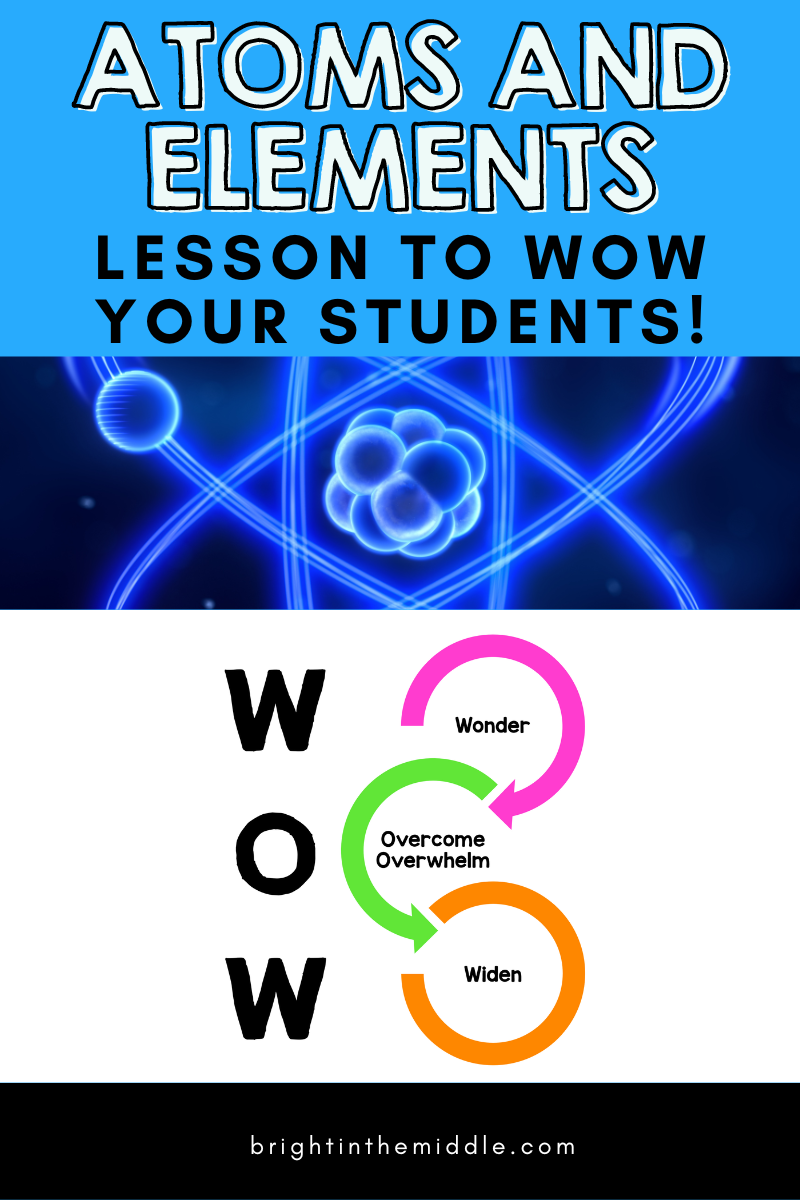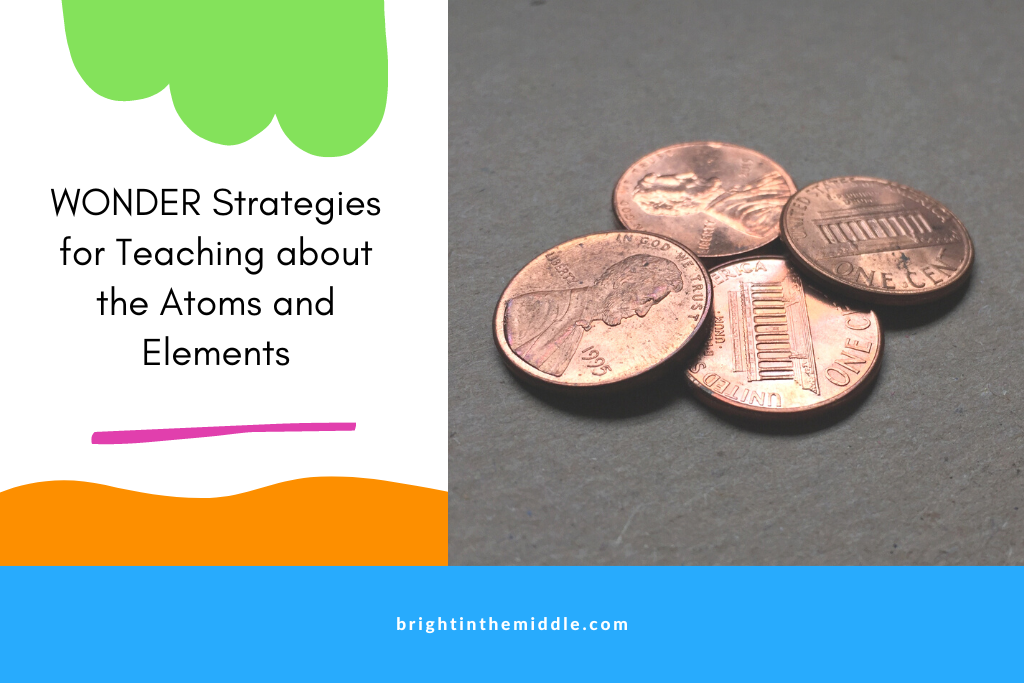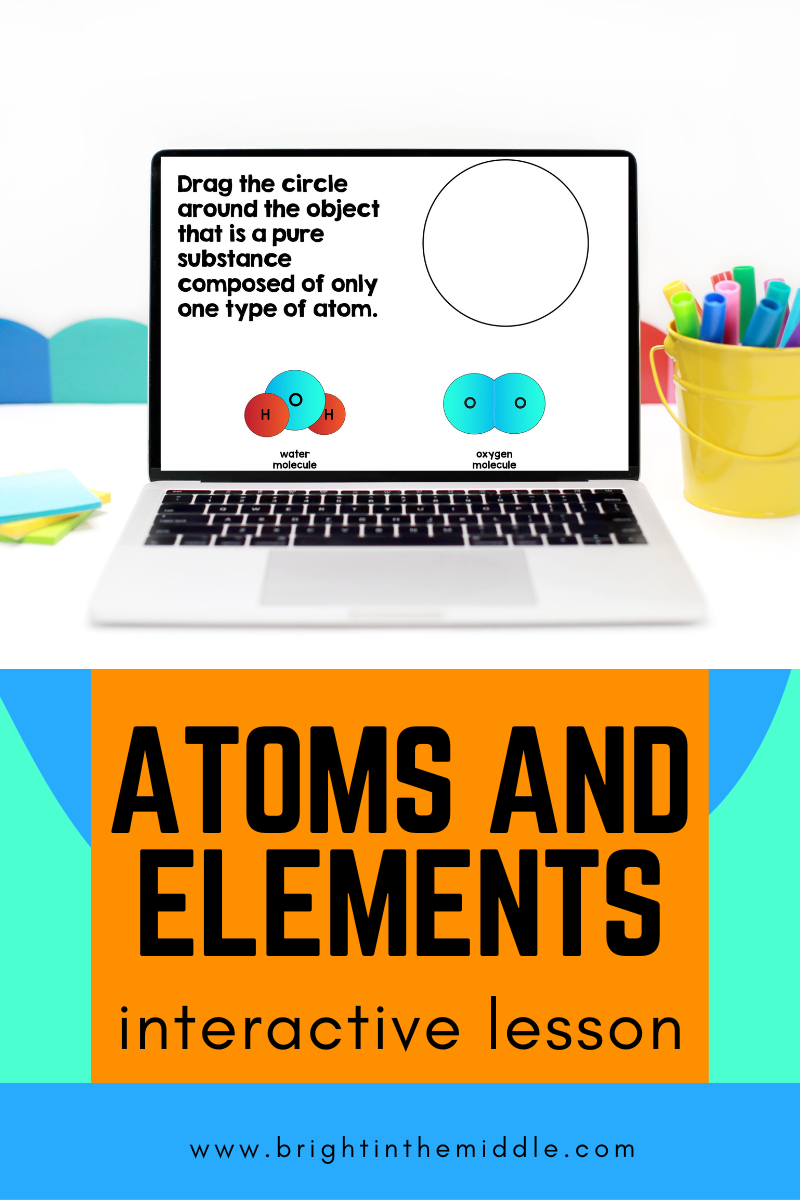Looking for atoms and elements activities for your next matter unit? Atoms are the fundamental building blocks of all matter. Matter is anything that has mass and takes up space! Matter makes up everything! This is anything we can see, touch, smell, or feel. For example, a computer, the teacher’s desk, an eraser, and even air is matter.
What are atoms and elements? As mentioned, atoms make up matter and understanding them is essential to how matter behaves. When atoms are grouped with other atoms of the same kind. They make up elements.
In this post, I have 7 WOW Factor ideas that you can bring to your classroom to get your students excited about learning this basic lesson in physical science.
First, I will share some ideas that get your students excited about learning and WONDERING what else they can learn.
Second, I will share an engaging lesson and activity that students will love! It helps them to OVERCOME the OVERWHELM of the information and science vocabulary.
Finally, I will share some atoms activities and elements activities to widen students’ knowledge so they can show off what they have already learned and gain more knowledge on the topic, even past what standards may call for.

Introductory Atoms and Elements Activities
Atoms can be something difficult for students to understand, especially in the lower middle grades because it can be considered abstract. We can’t exactly see it! However, it’s still something that students can be engaged in because it makes up items that we can see and deal with every single day.
Below, I share four activities you can try with your students to get them excited about atoms and elements. You can do one or try all three!
How Small is an Atom Activity
Trying to explain to a student how small an atom is can be challenging. So, why not do a demonstration? Although your students cannot see how small the atom is, you can give them a good idea!
You can choose this as a class activity and give students a chance to do the activity, but it depends on how much paper you want to deal with.
So, what is the activity?
You’ll need:
- a strip of paper 11” by 1”
- scissors
- First, you will take your 11” by 1” strip of paper.
- Fold it in half and then cut on the fold.
- Take one of those halves and do the same thing.
- Continue to fold and cut on the fold.
- Do this as maybe times as you can. It really gets difficult after 7-8 cuts.
Make sure that you and your students keep the paper oriented the same way each time they fold and cut.
Tell students that if they were able to do 31 cuts. This would be about the size of an atom!

Relationship Between Atoms and Elements Intro
This is an introductory activity where students use models of atoms and elements to show that matter is made up of atoms and elements and the types of atoms that compose them are the way that they are distinguishable.
In this activity, students look through 8 cards that represent atoms and 8 cards that represent elements. My observation and exploration, with a guided inquiry approach, students will ultimately determine that “matter is made of atoms and elements and are distinguished from each other by the types of atoms that compose them”
You can find this in the Bright in the Middle Shop and on TPT.

Elements Hands-on Exploration and Sort
Hands-on learning is always a way to get students excited about a topic. I have a great activity you can try with your students to help introduce the concept of atoms and elements.
I suggest placing students into groups of 3-4.
You’ll need a variety of different materials such as: pennies, sugar, salt, sand, paper clips, aluminum foil, baking soda, water, vinegar, oil, plastic beads, and rubber bands.
- Give students these materials and task them with sorting them into groups based on observable properties. They can sort them however they wish!
- As they are sorting, ask students to think about what the items are made of.
- After they have sorted. Have each group share out how they put the items into categories.
- Discuss any patterns. Also discuss any similarities and differences in the materials.
After, you’ll be ready to dive into the atoms and elements content!
Build an Atom PhET Simulation
Another activity you can have your student do is the Atom PhET simulation. It is a useful tool to introduce students to atoms and their structure. Its interactive and can help students understand some of these abstract concepts.
It may be beyond what a younger middle school student needs to learn, but it’s never to early to introduce them to the subatomic particles and have them to become familiar with them.
Just have them explore. Have them to look at how the atom changes as more protons are added. Have them to see if they can make stable atoms. There are so many things that they can explore!
Here are some questions you can ask while students explore:
- What is an atom and what makes up an atom?
- What relationships exists between the number of protons, neutrons, and electrons?
- How does the structure of an atom affect its properties?
- How are atoms and elements different?
- How are atoms and elements similar?
This is also a great widen activity as well. They can revisit this after they have learned more about atoms and elements. It will help them to tie things together.
Atoms and Elements Lesson
Now it’s time to dive into the content, and one of the best ways to do that is through interactive lessons. They are great for blended learning, direct instruction, self-paced learning, partners, and so much more!
Interactive lessons were created to reduce student cognitive load by using specific researched-based strategies to help students retain information. If students are overwhelmed and given a lot of information at one time, they end up not learning anything at all. It’s better to break things up.
How are atoms and elements related? Are atoms and elements matter? This particular atoms and elements interactive lesson helps students to learn the content through chunks with embedded activities to help students process the information.

This lesson covers the definition and examples of matter, atoms in living and non-livings, introducing the periodic table, atoms vs elements, pure substances, a brief overview of subatomic particles, and more!
Some of the embedded activities include answering questions, drag-and-drop activities, exploring outside resources, atoms and elements video, anticipation guide, and more! You can skip the atoms and elements worksheet with all of these activities! There are a lot of atoms and elements activities embedded in this one lesson!
Atoms and Elements Activities to Widen Knowledge
Your state gives you certain standards that students should meet; however, if time allows, it never hurts to learn more information! This is also a great time to reinforce the content that they did learn.
Here are some WIDEN activities to try with this topic.
Atomic Theory Timeline
In the lesson, students got a glimpse of the concept of the atomic theory and its development. Students learned about several different scientists that contributed to the development of this theory over time.
Now it’s time for them to dive in deeper.
You can choose to have students work in groups or in partners to research the key discoveries of the important scientists and their experiments.
After, students can create a timeline!
The timelines should include:
- the scientists
- dates
- events
- discoveries
They can get as creative as you’d like them to! They can make a large one to display in the classroom, a slide presentation, a miniature poster, or whatever you’d like them to do.
This can be as simple or as complicated as you’d like!
Element Scavenger Hunt
Another widen activity that you can do is to have them to complete an element scavenger hunt.
You should place different items around the room or outside for students to look for. Their goal will be to come up with a list of items that are made up of different elements.
Their list can come from some of the items that you placed around the classroom or they could be something that’s already in there! Some examples include:
- a penny (copper)
- pencil (graphite)
- nail (iron)
- plastic bag (polyethylene)
- chalk (calcium carbonate)
- a mineral of your choice
- aluminum foil (aluminum)
- a helium balloon
- table salt (sodium and chlorine)
After, students can share their list with each other to see how many they came up with!
You can have them to present their list any way that you wish!
Building Atoms Activity
Have you ever made models of atoms using candy or other sweets? This is a lot of fun, and it’s delicious! This is a great parts of an atom activity for students to engage in.
You’ll need:
- mini marshmallows (colors) or another candy of different colors
- mini chocolate chips
- plates or trays
- student sheets
- Provide each person/group an atom to model or allow them to choose. You can use the worksheet as a reference or research others.
- Provide each person/group with a plate or tray to collect their materials. They will also need a student sheet.
- Students can take their tray and collect “protons”, “neutrons”, and “electrons” from a designated spot.
- Students can fill out the information on the top of the student sheet, create their models, and answer the questions.
- Give students a chance to look at other classmates’ atom models. They will need this information for their worksheet.
To learn more about this activity, you can find it in the Bright in the Middle Shop and on TPT.


Are you able to create a bundle that has specific content material since I’m in CA some of your bundles have 6,7,8 materials in them.
Hi! I do not create custom bundles, but all of my resources (all access) can be found inside of the membership! You can learn more at http://www.brightinthemiddle.com/membership.